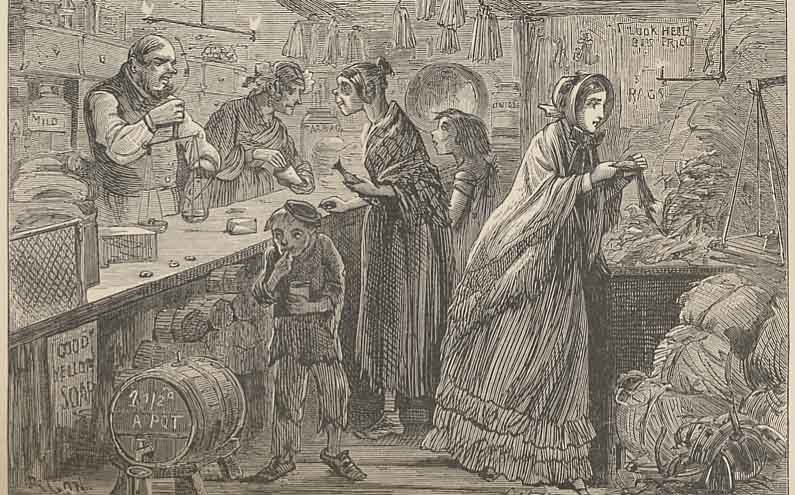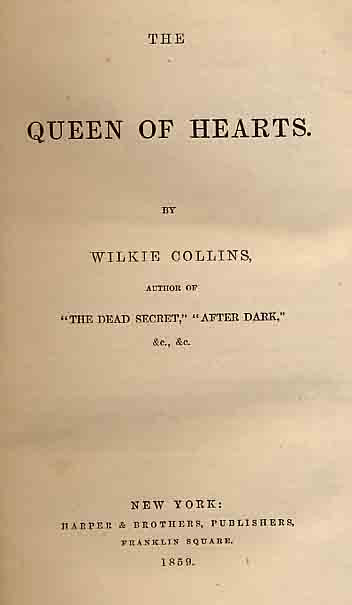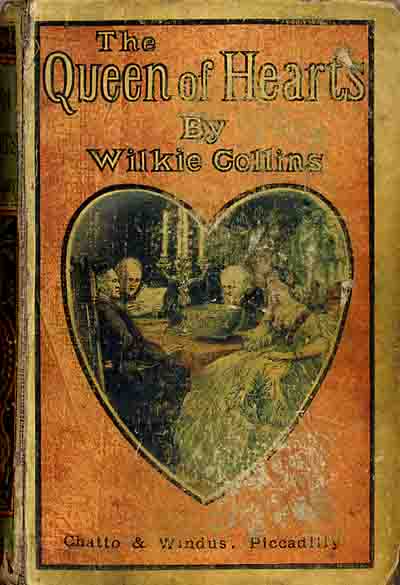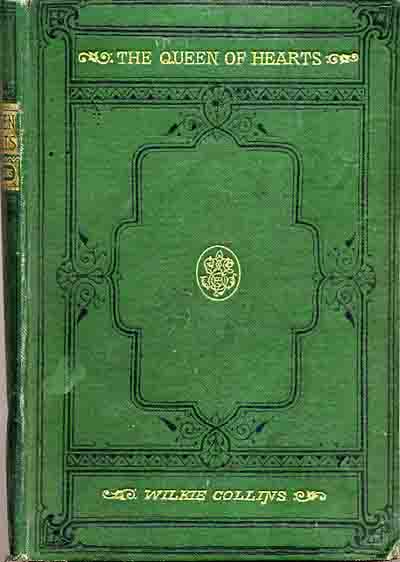[ Publishing History ] [ Front Page ]
[ Black Cottage ] [Family Secret ] [ Dream Woman ] [Mad Monkton ] [ Dead Hand ]
[ Biter Bit ] [ Parson's Scruple ] [ Plot in Private Life ] [ Fauntleroy ] [ Anne Rodway ]
|
|
|
| 1879 Chatto & Windus yellowback | 1872 Smith, Elder edition in limp cloth |
Collection of ten short stories set within the connecting narrative of
'The Queen of Hearts'. Dedicated
to Emile Forgues. 'The Queen of
Hearts' is the school nickname of Jessie Yelverton who arranges to stay for
six weeks with her elderly guardian, Griffith, a retired lawyer.
Griffith lives with his two brothers, Owen the clergyman and Morgan the
doctor, in an isolated house in South Wales.
Griffith's son, George, is in love with Jessie and the three brothers
set out to delay her departure for ten days so that George can propose on his
return from the Crimean war. In a
kind of Arabian Nights story-telling, the three brothers draw on their
professional experiences to entertain their young guest with a different story
each evening:
Brother Owen's Story of The Black Cottage
Short story originally published as 'The Siege of the Black Cottage' in Harper's New Monthly Magazine, February 1857.
Bessie is a stonemason's daughter left alone in her cottage on the moors
one night to look after a valuable pocket-book.
She successfully protects herself, the money and Polly, the cat, from
two violent burglars. An early
example by Collins of a courageous and resourceful female character.
Brother Griffith's Story of The Family Secret
Short story originally published as 'Uncle George; or, the Family
Mystery' in The National Magazine, November 1856.
Charley, the narrator, spends many years trying to discover the family secret from his relatives. He finally learns by chance that his beautiful young sister died when Uncle George, a doctor, performed a rash operation to remove an unsightly tumour from her neck.
Brother Morgan's Story of The
Supernatural short story originally published as 'The Ostler', second
part of 'The Holly Tree Inn', the Extra Christmas Number of Household Words
for December 1855. It was adapted
by Collins for his reading tour of America and enlarged within a narrative
framework for The Frozen Deep and Other
Stories (1874).
Isaac Scatchard, an itinerant ostler, wakes on the night of his birthday
to see the apparition of a woman trying to stab him with a clasp knife.
Seven years later he marries Rebecca Murdoch, against the wishes of his
mother who recognises her from Isaac's description as the dream woman.
Rebecca takes to drink and fulfills the prophecy by attacking him on
his birthday. She disappears and
Isaac can never again sleep at night for fear she will return to kill him.
Brother Griffith's Story of Mad Monkton
Short
story with supernatural overtones first published as 'The Monktons of Wincot
Abbey' in Fraser's Magazine, Nov--Dec 1855.
The story was originally offered to Household Words in 1853 but
declined by Dickens who thought the
theme of hereditary madness unsuitable for a family magazine.
The
Monktons are a reclusive, ancient family afflicted by hereditary insanity.
The young Alfred Monkton is obsessed by a family curse and haunted by
the ghost of his uncle, killed in a duel.
Alfred delays his marriage in order to travel to Naples to search for
the body, convinced that he will be the last of the line if his uncle is not
buried in the family vault.
The
decomposing corpse is eventually discovered outside a Capuchin convent.
Sealed in a lead coffin, it is taken by sea for burial in England but a
violent storm sinks the ship and the coffin is irretrievably lost.
Monkton dies of brain fever and, last of the line, is buried in the
family vault where one niche remains empty, that intended for his uncle.
Brother Morgan's Story of The Dead Hand
Short story originally published as 'The Double-Bedded Room' in Household
Words, 10 October 1857; it forms the second chapter of 'The
Lazy Tour of Two Idle Apprentices'.
It was possibly based on an anecdote in J. G. Lockhart's Life of Sir
Walter Scott (Edinburgh, 1837-38). The
physical description of the 'dead' man, however, was that of a doctor's
assistant Collins and Dickens met on their tour.
Collins later used his strange appearance for the character of Ezra
Jennings in The Moonstone.
Arthur Holliday arrives in Doncaster during the busy September race-week.
The only accommodation he can find is a shared room with a body
occupying the other bed. His
apparently dead companion revives in the night.
He has an uncanny resemblance to Arthur and years later is found to be
his illegitimate half-brother.
Brother Griffith's Story of The Biter Bit
Short story originally published as 'Who is the Thief?' in The Atlantic Monthly, April 1858. It is an early example of a humorous detective story, featuring a comically inept detective and other features of the genre.
Mathew Sharpin is seconded from his position as a lawyer's clerk to the
Detective Police. He bungles an
investigation into Mr Yatman's stolen banknotes while mistakenly pursuing an
eloping couple. To the
gratification of his superiors who have been promoted on merit, they are
easily able to deduce from his rambling reports that the true culprit is the
extravagant Mrs Yatman.
B
Short story originally published as 'A New Mind' in Household Words, 1 January 1859.
The puritanical Reverend Alfred Carling marries privately Mrs Emily
Dunbar. Several years later he
learns that she is divorced and that he has innocently violated his own
religious principals. Despairing
but still in love, he leaves the country for missionary work in the South Seas
only to die shortly after at sea.
Brother Griffith's Story of A Plot in Private Life
Short story originally published as 'A Marriage Tragedy' in Harper's
New Monthly Magazine, February 1858. Also
the title for the Tauchnitz edition containing five stories from The Queen
of Hearts.
William, the narrator and faithful servant to rich widow, Mrs Norcross,
tells the story of her unhappy second marriage to James Smith.
A detective lawyer's clerk, Mr Dark, both confirms Smith's bigamous
remarriage and, following his disappearance, proves Mrs Norcross and William
innocent of murder. Dark also
recovers jewellery stolen by the maidservant and establishes her guilt.
William's amiable relationship with the experienced detective
foreshadows that between Betteredge and Cuff in The
Moonstone (1868).
Brother Morgan's Story of Fauntleroy
Short story originally published in Household Words, 13 November
1858, as 'A Paradoxical Experience'. Also
included in Remember. A Keepsake, New York [1874] and in Readings
and Recitations from Modern Authors, Chicago 1890.
Henry Fauntleroy (1785-1824) was the last man hanged in England for
forgery. A middle-aged merchant,
Mr Trowbridge, tells the other side of the story.
The forger not only helped him as a young man start in business but
also protected his interests when the bank that Fauntleroy ruined was forced
to close.
Brother Owen's Story of Anne Rodway

Short story originally published in Household Words 19-26 July
1856. It features possibly
the first fictional female detective and an early example by Collins of
episodic diary narrative. As in
much of his work, there is a deformed character.
Set in 1840, Anne Rodway is a poor 'plain needlewoman' whose friend and fellow lodger, Mary Mallinson, is brought home mortally wounded by a blow to the head. Anne follows the clue of a torn cravat clutched in her dying friend's hand and sets out to discover the murderer. She is assisted by her fiancee, Robert, who has just returned from America and they bring to justice Noah Truscott, the perpetrator of the crime.

Title-page to the Harper's first US edition in 1859
Serialisation
See individual stories.
Book publication
First edition
3 volumes, Hurst & Blackett, London 1859.
Grey-green cloth, covers blocked in blind, spines lettered in gilt, pale
yellow end-papers. No half-titles.
Published in October 1859.
Vol I
(vi) [paged (iv)] + 314 pp. 16
pp publishers' catalogue, undated, bound
in at end.
Vol II
(ii) + 360 pp
Vol III (ii)
+ 308 pp
1 volume editions
Sampson Low 1862 (with a frontispiece by J. Gilbert); Smith, Elder
1865-1874; Chatto & Windus 1875-1911 (with 8 illustrations by A. Concanen).
First US edition
Harpers, New York 1859.
[
Top
of Page ] [ Back
to Main Works

